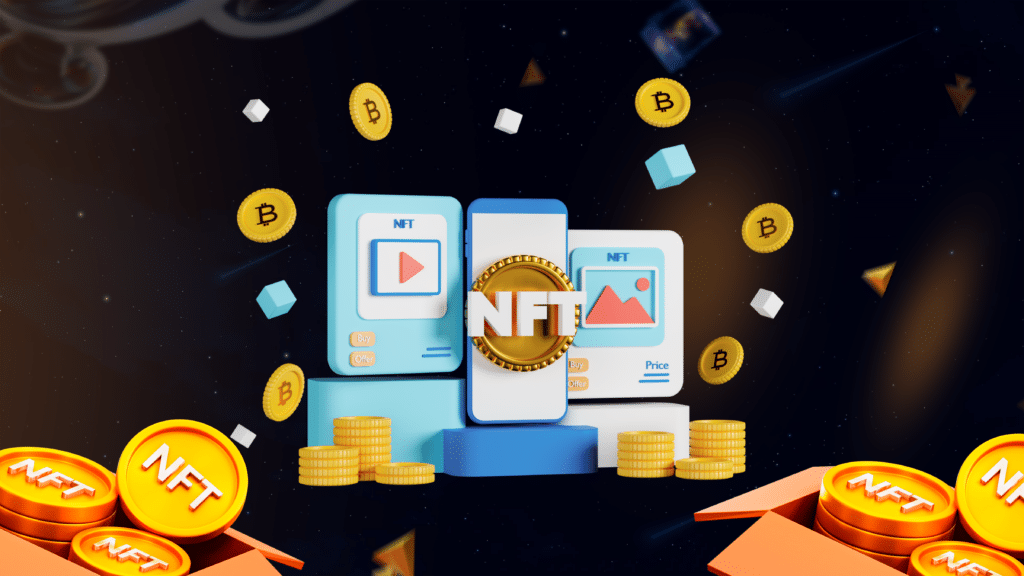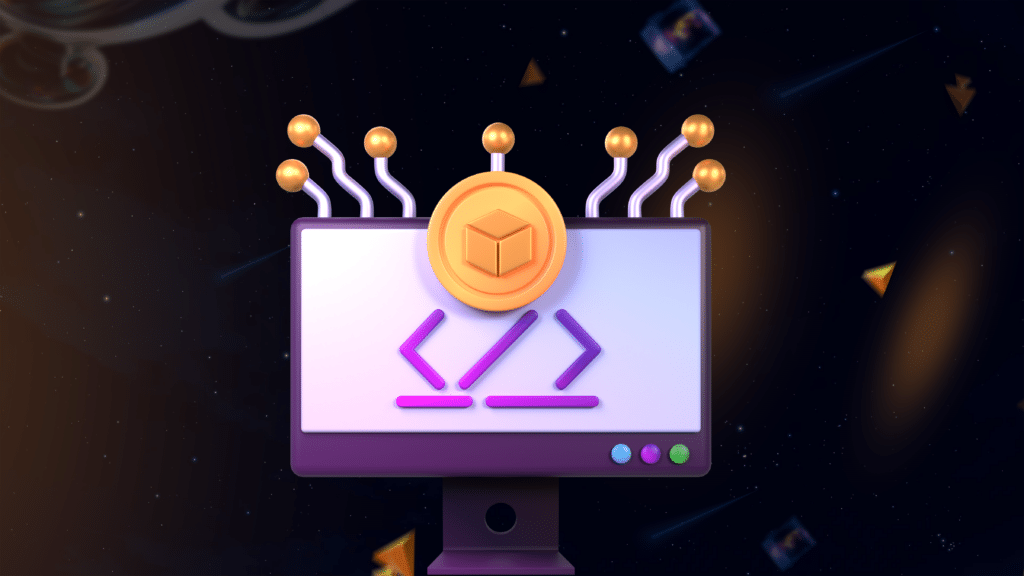You’ve probably heard of NFTs by now—maybe you even associate them with those funny monkey pictures that went viral. Believe it or not, those monkey digital images have sold for millions, sparked intense debates, and reshaped the way we think about ownership in the digital age.
So… what exactly is an NFT, and why do people keep talking about them in 2025?
In this NFT beginner guide, we’ll break down everything you need to know—no tech jargon, no blockchain degree required. From how NFTs work to why they’re more than just internet memes, we’ll explore:
- What NFTs actually are (hint: it’s not just about the image)
- Why NFTs have value—and why people are still buying them
- How you can buy, sell, and even create your own NFTs
- Real-world examples across art, gaming, music, and more
What is an NFT?
What is an NFT? NFTs is short for Non-Fungible Tokens. But if we are to truly unpack the term “NFT”, we’ll have to break it down in two separate components. To understand this, let’s take the term “fungible” assets. We know that currency is a fungible asset and each unit of it is interchangeable, a dollar for a dollar. In contrast, “Non-Fungible” is something that is unique and irreplicable; something that is one of a kind like a famous painting. Even if there are copies of it out there, you know the value of the original is monumental.
The second term is “token” which is being used to give provenance to the digital asset recorded on a blockchain. To combine the two, we have an NFT which is a singular digital entity that cannot be replicated. Since it is a digital certificate of ownership, its representation can be of several kinds. For instance, a digital artwork or tokenized physical asset, etc. What distinguishes the NFTs is the inherent uniqueness which is verified by blockchain technology.
How NFTs Work
Blockchain technology is the backbone of how NFTs function. At its core, a blockchain is a decentralized and immutable digital ledger that records transactions and verifies ownership without the need for intermediaries.
This technology is what makes NFTs secure, transparent, and fully traceable, ensuring that each digital asset is authentic and tamper-proof from the moment it’s created to every time it’s transferred.
Now that you understand the basics, let’s walk through the step-by-step process of how NFTs are created, stored, and transferred using blockchain technology.
Minting: Creating an NFT
Minting is the process of turning a digital file—like an artwork, song, video, or even a document—into a unique NFT recorded on the blockchain.
- When you mint an NFT, the asset is uploaded to the blockchain and given a unique token ID, making it one-of-a-kind, verifiable, and tamper-proof.
- This process ensures authenticity and traceability from the moment the NFT is created.
Smart Contracts: Enabling Secure Transactions
Once an NFT is minted, the next step is enabling secure, trustless transactions—this is where smart contracts come into play.
- Smart contracts are self-executing pieces of code written directly onto the blockchain.
- They handle the automatic transfer of ownership, enforce terms of sale, and eliminate the need for middlemen.
- The result? Secure, transparent, and efficient NFT transactions every time.
Blockchain Platforms & Token Standards
To understand how NFTs work at a technical level, it’s helpful to learn about the blockchain networks and token standards that power them.
The most widely used blockchain for NFTs is Ethereum, which supports:
- ERC-721: The standard for creating unique, non-fungible tokens.
- ERC-1155: A more flexible standard that allows multiple token types (fungible and non-fungible) in a single smart contract—ideal for gaming and collectibles.
Other emerging platforms include:
- Solana – Known for its speed and low transaction fees.
- Polygon – A scalable Ethereum-compatible Layer 2 solution, popular for eco-friendly minting.
While Ethereum still dominates the NFT landscape, Solana and Polygon are gaining traction, especially among newer and cost-conscious creators.
Crypto Wallets: Storing & Managing Your NFTs
Once you purchase or mint an NFT, you need a crypto wallet to store and manage it.
- These digital wallets allow you to buy, sell, transfer, and view your NFTs across supported marketplaces.
- Popular wallets include:
- MetaMask (Ethereum & Polygon)
- Phantom (Solana)
- Coinbase Wallet (multi-chain support)
- Your wallet connects directly to platforms like OpenSea, Magic Eden, or our favorite, Spaace, making it easy to trade and showcase your digital assets.
A Brief History of NFTs

Let’s shift focus for a moment and go back in history to the very beginning. While most people associate NFTs with flashy art and million-dollar sales, the concept actually dates back to 2012, when developers on the Bitcoin blockchain experimented with “colored coins”—an early form of tokenized assets. These tokens hinted at what would later evolve into non-fungible digital ownership. Fast forward to 2014, and we see the creation of Quantum by Kevin McCoy—widely recognized as the first true NFT.
In 2016, digital collectibles started to gain traction with the rise of Rare Pepes, meme-based assets traded as digital art. But it was in 2017 that NFTs truly entered mainstream awareness, thanks to CryptoPunks, a pioneering project on Ethereum that laid the groundwork for NFTs as we know them—unique, blockchain-verified, and tradable pieces of digital art. That same year, CryptoKitties further demonstrated how NFTs could be used in gaming and entertainment, crashing the Ethereum network due to overwhelming demand.
The NFT boom of 2021 marked a turning point, with record-breaking sales like Beeple’s $69.3 million digital collage, auctioned at Christie’s. This moment propelled NFTs into the global spotlight, attracting artists, collectors, celebrities, and brands alike. However, 2022 and 2023 brought a market correction, revealing the volatility of NFTs as digital assets and filtering out unsustainable projects.
Despite the ups and downs, NFTs remain a thriving and rapidly evolving space. From art and gaming to music, real estate, and identity, the use cases for NFTs continue to grow—and with blockchain technology improving, the future of NFTs in 2025 and beyond looks more promising than ever.
Common Use Cases for NFTs
By now, this NFT beginner guide has made it clear—NFTs are far more than just digital art. They’ve evolved into powerful tools with real-world applications across multiple industries. From gaming and real estate to music, memberships, and intellectual property, NFTs are proving to be as versatile and transformative as the technology behind them.
Here are some of the most popular and practical use cases for NFTs in 2025:
NFTs in Fine Art: Empowering Creators and Collectors
One of the most transformative use cases for NFTs is in the digital art world. Imagine if artists could sell their work directly to collectors and earn automatic royalties every time it’s resold—that’s exactly what NFT technology enables.
Thanks to the blockchain, artists can now verify authenticity and ownership of their creations, eliminating the need for middlemen and protecting their intellectual property. A landmark moment in NFT art history was when digital artist Beeple sold his piece, “EVERYDAYS: The First 5000 Days”, for a record-breaking $69.3 million at Christie’s.
Whether you’re a digital artist looking to monetize your work or a collector seeking rare, authenticated pieces, NFTs offer an entirely new way to create, buy, and sell art in the digital age.
NFTs in Gaming: Turning Skill Into Real-World Value
What could make a traditional video game even more exciting? The ability to earn real-world value based on your in-game performance. That’s exactly what NFTs in gaming are doing—transforming how players interact with digital worlds by allowing them to own, trade, and profit from in-game assets.
NFTs can represent everything from virtual land and rare characters to weapons, skins, and collectibles. Popular play-to-earn (P2E) games like Axie Infinity and Decentraland have already proven this model works. In these games, players can earn NFTs by leveling up, completing challenges, or winning battles—effectively creating a virtual economy where in-game success translates to real-world rewards.
This integration of NFTs brings true ownership to gamers, increases engagement, and opens the door to a future where gaming becomes both fun and financially empowering.
NFTs in Music: Exclusive Access, Ownership, and Royalties
Music fans have always loved collecting rare memorabilia and exclusive content from their favorite artists. With the rise of music NFTs, that experience has been completely redefined. Today, artists can offer their fans exclusive digital music, limited-edition artwork, behind-the-scenes content, and even virtual or real-world experiences—all through blockchain-powered NFTs.
What’s more, artists don’t lose control of their work. In fact, NFTs give them more ownership and financial independence than ever before. Through the use of smart contracts, creators can automatically earn royalties every time their NFT is resold, ensuring fair compensation and long-term revenue.
For both musicians and fans, NFTs are creating a more direct and rewarding relationship, making it possible to support artists while owning a piece of music history in digital form.
Other Applications
Beyond the three applications mentioned above, there are other avenues where NFTs are currently being utilized. For instance, NFTs are a perfect way to tokenize licenses and certifications to ensure secure verification. Fashion brands and real estate are always on the lookout for unique ownership and experiences and NFTs are a great way to make that happen. Hence, if you wish to know how to invest in NFTs, begin this NFT beginner guide by knowing their diverse applications. In this way, you will be in a great position to navigate the complex landscape and identify potential opportunities.
NFT Guide for Beginners: How Buying and Selling Works
Now that you’re aware of the usecases, you’re ready to learn how to buy and sell NFTs. Here’s a step-by-step process provided by our NFT beginner guide:
- Choose an NFT Marketplace: Several reputable platforms are out there like Spaace NFT Marketplace, OpenSea, Blur, etc. Find one that aligns with your interests, go through their fees, what blockchain they support and how’s their user interface.
- Set Up a Crypto Wallet: MetaMask or Trust Wallet are common crypto wallets which you will need. You can install their extension or the app and store the seed phrase there securely. Add the required cryptocurrency funds like ETH.
- Connect Your Wallet: Next up, you need to bring together the crypto wallet and the NFT marketplace. Only then will you be able to browse, buy, or sell NTFs directly.
- Buy NFTs: After browsing, you will find one that you like. Make sure to check all the details like the price, the fees involved, including the gas fees (transaction costs on the blockchain). Once you’re ready to buy, confirm the transaction through the crypto wallet.
- Sell NFTs: Selling NFTs is the opposite of the buying process where you are the one who uploads your asset on the marketplace. You set a fixed price or in auction form. You add all the details of the NFT you own and can even promote it to potential buyers.
- Understand Transaction Fees: Fees vary depending on the marketplace and blockchain network you choose. Common types of fees involved are gas fees, marketplace fees, and potential royalties.

Final Thoughts
That’s all for our NFT beginner guide. A paradigm shift in digital ownership is what NFTs represent, offering unique and verifiable assets. On one hand, they transcend beyond the art and gaming industry towards more practical applications. On the other hand, we will have to encounter risks such as volatility and scams/frauds. Regardless of it all, NFTs are here to stay and will continue to evolve, which makes it critical that we participate in an informed manner.
So go out there, explore the marketplaces, but make sure to pair your excitement with caution!

